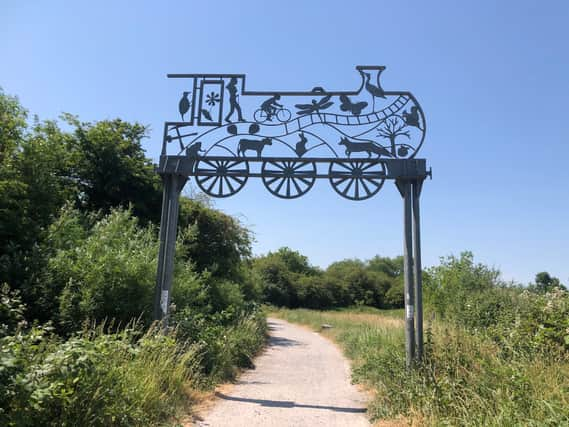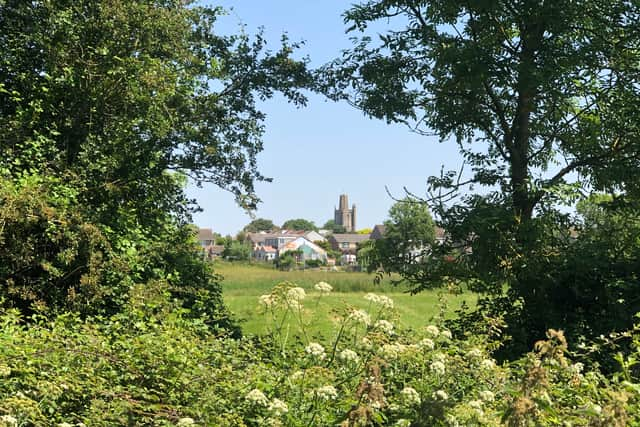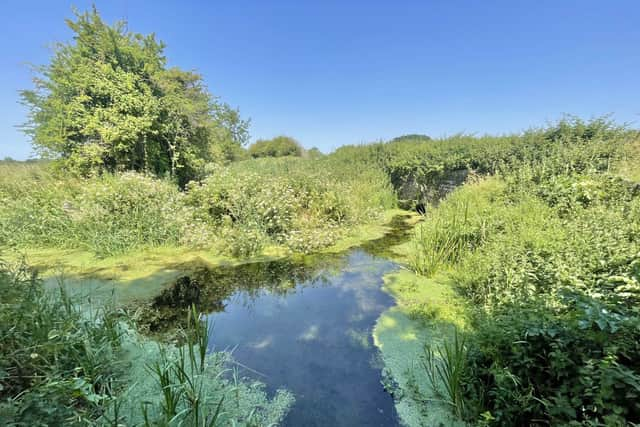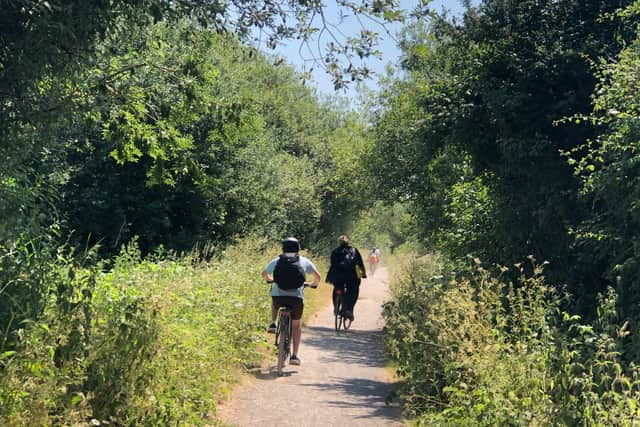I went on a stunning walk along a former railway line path near Bristol


They mention the water voles and barn owls on the waymarker signs along the Strawberry Line path but they forgot to mention the MAMILs.
There we were - myself and my teenage daughter lagging behind - enjoying the tranquility of bird song and distant bleating sheep when several middle-aged men in lycra flashed past.
Advertisement
Hide AdAdvertisement
Hide AdNo warning and certainly no courteous ‘thank you’ as we jumped aside into the towering nettles and fragrant elderflowers - these off-road cyclists were soon gone in a colourful cloud of dust.
We should have guessed our gentle walk from outside Yatton railway station to Congresbury might encounter a few cyclists, but we didn’t quite anticipate the sheer volume.
Those on two wheels certainly outnumbered the people on foot during this first pretty if narrow stretch of the Strawberry Line.
The walk itself took us about 40 minutes but it was blisteringly hot and there was plenty of stop-start from the ‘are we there yet?’ teenager.
Advertisement
Hide AdAdvertisement
Hide Ad‘This is worse than the DofE walks,’ harrumphed my daughter after only ten minutes of ambling along the flat path, occasionally stopping for a selfie or TikTok.
For this phone obsessed indoors-type, it must have felt like a gruelling expedition. But it was good to see her in the great outdoors and she soon warmed to the idea.
We’d started the walk at the ornate iron entrance near Yatton railway station. The path follows the old railway branch line from Yatton to Cheddar, which opened in 1869 and closed in 1963.
It’s called the Strawberry Line because this was the route trains from the Mendips took when transporting Cheddar’s world-famous strawberries every summer.


Advertisement
Hide AdAdvertisement
Hide AdThe strawberries would be picked in Somerset and sent on the train to London fruit markets at Covent Garden, from where they would be sent all over the UK.
The first part of the walk runs through an area where there were once railwaymen’s allotments and some of their fruit trees still survive. The final section into Cheddar brushes past pick-your-own soft fruit farms so you can have the complete strawberry experience in summer.
For decades closed and derelict, British Rail sold the land in 1997 but they were persuaded to withdraw it from auction so that the community could buy it and the land was given over to North Somerset Council to complete the Strawberry Line from Yatton to Cheddar, a 17km stretch through the Mendip Hills and North Somerset.


As well as strawberries, the line was also used to transport stone from Mendip quarries, coal, milk from local dairies and passengers. After almost a century, this important branch line was one of the many to close under the Beeching cuts and it carried its last passengers in September 1963.
Advertisement
Hide AdAdvertisement
Hide AdThe Yatton to Congresbury section of the path we walked follows the same winding curves as the old track would have done.
It follows the edge of wetlands on one side and fields backing on to houses in Yatton village on the other. From most vantage points at the start of the walk, it’s possible to see the spire of the stunning 14th-century St Mary’s Church in Yatton.


During our walk, we passed hidden rhynes (water-filled ditches), farms and meadows of wild flowers. Apart from the sounds of approaching cyclists (and, let’s face it, it is part of the National Cycle Network so they are more than welcome to use it alongside walkers), it was tranquil and relaxing, although there was a series of easyJet planes descending to land at Bristol Airport for much of our walk.
At one point, we had to cross a tiny bridge over a rhyne where we glimpsed a water vole. In June and July, apparently kestrels, sparrow hawks and buzzards soar overhead, as do bats at dusk. You might even catch sight of a barn owl, although all we spotted were several types of butterfly.
Advertisement
Hide AdAdvertisement
Hide AdThankfully, there are benches along the walk to rest weary legs. Each has an engraved dedication for walkers no longer with us - ramblers such as Ted Harris ‘who loved the wildlife on the Strawberry Line, especially the barn owls’.
On the final stretch before reaching Congresbury and crossing the River Yeo, we came across the unusually named Biddle Street, a nationally important wetland and a Site of Special Scientific Interest because of the wildlife and colourful plants like meadowsweet.
Even the moody teenager admitted she had enjoyed the walk despite the heat, sore feet, bugs and hayfever.
By the time we reached Congresbury to get the bus back to Bristol, she was asking if we could do the next part of the Strawberry Line walk over the summer, the bit that takes you through to Sandford and the Thatchers cider orchards.
With the prospect of a cold pint of cider at the end of that walk (Thatchers have a pub called The Railway Inn at Sandford), I’d happily carry my daughter for the last few yards.
Comment Guidelines
National World encourages reader discussion on our stories. User feedback, insights and back-and-forth exchanges add a rich layer of context to reporting. Please review our Community Guidelines before commenting.
